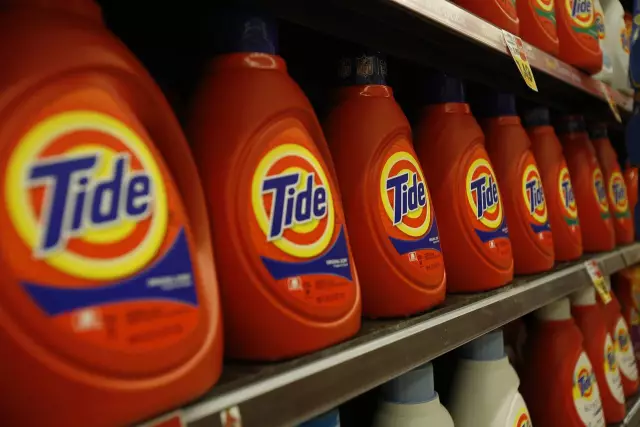- Author Rachel Wainwright [email protected].
- Public 2023-12-15 07:39.
- Last modified 2025-11-02 20:14.
Benzylpenicillin sodium salt
Latin name: Benzylpenicillin sodium
ATX code: J01CE01
Active ingredient: benzylpenicillin (Benzylpenicillin)
Manufacturer: Krasfarma OJSC (Russia); Synthesis JSC (Russia); Shandong Weifang Pharmaceutical Factory Co. (Shandong Weifang Pharmaceutical Factory) (China)
Description and photo updated: 30.11.2018

Benzylpenicillin sodium salt is an antibiotic of the group of biosynthetic penicillins for systemic use, which has a bactericidal effect.
Release form and composition
Dosage forms:
- powder for the preparation of a solution for intravenous (i / v) and intramuscular (i / m) administration: white powder with a weak specific odor [1,000,000 U (action unit) or 500,000 U in vials, in a cardboard box 1 or 10 vials, for hospitals - in a cardboard box of 50 vials];
- powder for preparation of a solution for intramuscular and subcutaneous (subcutaneous) administration: white powder with a weak specific odor (1,000,000 U or 500,000 U in 10 ml vials, in a cardboard box 1, 5 or 10 vials, for hospitals - in a cardboard box, 50 bottles each);
- powder for preparation of solution for injection and local use: white powder with a weak specific odor (1,000,000 U or 500,000 U in 10 ml or 20 ml vials, in a cardboard box 1, 5 or 10 vials, for hospitals - in cardboard box of 50 bottles).
Each pack also contains instructions for the use of Benzylpenicillin sodium salt.
1 bottle contains the active ingredient: benzylpenicillin sodium salt - 500,000 units or 1,000,000 units.
Pharmacological properties
Pharmacodynamics
Benzylpenicillin sodium salt is an antibacterial drug of the group of biosynthetic (natural) penicillins, has a bactericidal effect, is destroyed by penicillinase. The mechanism of action of its active substance is due to inhibition of transpeptidase and prevention of the formation of peptide bonds. By disrupting the late stages of cell wall peptidoglycan synthesis, it causes lysis of dividing bacterial cells.
Benzylpenicillin is active against the following pathogens:
- gram-positive microorganisms: Bacillus anthracis, Streptococcus speciales (spp.) (including Streptococcus pneumoniae), Staphylococcus spp. (not producing penicillinase), Corynebacterium spp. (including Corynebacterium diphtheriae), Actinomyces spp.;
- gram-negative microorganisms: Neisseria meningitidis, Neisseria gonorrhoeae, Treponema spp., class Spirochaetes.
Penicillinase-producing microorganisms are resistant to benzylpenicillin sodium salt: Staphylococcus spp., Most viruses, gram-negative bacteria, including Pseudomonas aeruginosa, Rickettsia spp., Protozoa.
In recent years, the sensitivity to benzylpenicillin of hemolytic streptococci, gonococci, staphylococci and pneumococci has changed.
Pharmacokinetics
After i / m administration, the maximum concentration of benzylpenicillin in the blood plasma is reached in about 0.5 hours.
Plasma protein binding is 60%.
Benzylpenicillin penetrates the placental barrier, with inflammation of the meningeal membranes, it crosses the blood-brain barrier. It is widely distributed in tissues, organs and body fluids (except for eye tissues, cerebrospinal fluid and prostate gland).
It is excreted through the kidneys unchanged. The half-life (T 1/2) is 0.5-1 hour, with renal failure - from 4 to 10 hours or more.
Indications for use
The use of Benzylpenicillin sodium salt is indicated for the treatment of the following bacterial infections caused by pathogens sensitive to penicillin:
- respiratory tract and ENT organs (ear, throat, nose): tonsillitis, bronchitis, community-acquired pneumonia, purulent pleurisy, scarlet fever, diphtheria, pulmonary actinomycosis;
- biliary tract: cholecystitis, cholangitis;
- genitourinary system: syphilis, gonorrhea, cystitis, colpitis, endometritis, endocervicitis, salpingo-oophoritis, adnexitis;
- skin and soft tissues, wound infections: impetigo, erysipelas, secondarily infected dermatoses;
- organ of vision: conjunctivitis, dacryocystitis, blepharitis;
- cardiovascular system: septic endocarditis;
- musculoskeletal system: osteomyelitis;
- central nervous system: meningitis;
- other infections: anthrax, sepsis, peritonitis, etc.
Contraindications
Absolute:
- breast-feeding;
- hypersensitivity to other penicillins, cephalosporins and benzylpenicillin.
In addition, endolumbar administration of the drug is contraindicated in patients with epilepsy.
With extreme caution, it is recommended to prescribe benzylpenicillin sodium salt for renal failure, patients with heart failure, diseases of allergic origin (including drug hypersensitivity, urticaria, hay fever, bronchial asthma) and in case of diagnosed hypersensitivity to β-lactam antibiotics of the Cephalosporin class (due to cross-allergy).
During pregnancy, the use of the drug is possible only in cases where the expected clinical effect for the mother exceeds the potential threat to the fetus.
Benzylpenicillin sodium salt, instructions for use: method and dosage
A ready-made solution of benzylpenicillin sodium salt is administered intravenously (drip or jet), intramuscularly, subcutaneously, intracavitary (into the abdominal, pleural and other cavities), intrathecally (endolumbar), topically.
Before the first administration, you must make sure that the drug and novocaine are tolerated (if used as a solvent). For this, patients should undergo an intradermal test.
It is necessary to prepare a solution of benzylpenicillin sodium salt immediately before the administration procedure, depending on the method of application, observing the following requirements:
- solution for jet intravenous injection: as a solvent for the contents of a bottle of 1,000,000 U, 5 ml of sterile water for injection or 0.9% sodium chloride solution is required;
- solution for drip intravenous administration: use 0.9% sodium chloride solution or 5% glucose solution in a volume of 100-200 ml per 2,000,000-5,000,000 IU of antibiotic as a solvent;
- solution for intramuscular injection: the contents of the vial are dissolved in sterile water for injection, 0.9% sodium chloride solution or 0.5% procaine solution, using 1-3 ml of solvent;
- solution for s / c injection: the powder is dissolved in 0.25-0.5% solution of procaine (novocaine), observing the following proportions: for 500,000 units, 2.5-5 ml is required, for 1,000,000 units, 5-10 ml solvent;
- solution for injection into the body cavity: to dissolve the antibiotic when injected into the abdominal, pleural or other cavity, use sterile water for injection or 0.9% sodium chloride solution;
- solution for intrathecal administration: the contents of the vial are dissolved in sterile water for injection or 0.9% sodium chloride solution in a proportion of 1000 IU of active substance - 1 ml of solvent. The resulting solution is mixed with the cerebrospinal fluid (CSF) extracted from the spinal canal in equal proportions, 5-10 ml of antibiotic solution is added to 5-10 ml of CSF;
- eye drops [prepared ex tempore (as needed)]: add sterile water for injection 5-25 ml per 500,000 IU or 0.9% sodium chloride solution 10-50 ml per 1,000,000 IU to the contents of the bottle;
- nasal drops and ear drops: sterile water for injection 5-50 ml per 500,000 U or 0.9% sodium chloride solution 10-100 ml per 1,000,000 U is added to the contents of the bottle.
The intravenous solution can be injected as a jet slowly over 3-5 minutes or drip, at a rate of 60-80 drops per minute.
IM injections are made in the upper outer square of the buttock deep into the muscle.
Intrathecal benzylpenicillin sodium salt should be administered at a rate of 1 ml per minute.
Recommended dosage:
- i / v and i / m introduction: adults - 250,000-500,000 IU 4-6 times a day for the treatment of moderate infections. The daily dose of the drug for severe infections can range from 10,000,000 to 20,000,000 U, with gas gangrene - up to 40,000,000-60,000,000 U. The daily dose for children is determined taking into account the weight of the child: at the age of 1 year - 50,000-100,000 U per 1 kg of the child's weight, over 1 year old - 50,000 U per 1 kg. If necessary, it can be increased to 200,000-300,000 U per 1 kg of body weight, and in terms of vital signs and up to 500,000 U per 1 kg. The daily dose is divided into 4-6 injections. IV Benzylpenicillin sodium salt is usually administered 1-2 times a day, the rest of the daily dose is administered i / m;
- s / c administration: in the form of injecting infiltrates with a solution with a concentration of 100,000-200,000 U per 1 ml of 0.25-0.5% solution of procaine;
- introduction into the body cavity: adults - the concentration of the solution is 10,000-20,000 U in 1 ml of solvent, children - 2000-5000 U in 1 ml. The duration of treatment is 5-7 days. Then the patient is transferred to the / m introduction of benzylpenicillin sodium salt;
- intrathecal (endolumbar) for purulent diseases of the meninges, brain and spinal cord: adults - in a daily dose of 5000-10,000 IU, children over the age of 1 year - 2000-5000 IU, once a day for 2-3 days, then the patient is transferred to the / m introduction;
- topically (only powder for preparation of solution for injection and topical use): eye diseases - instillation of 1-2 drops 6-8 times a day of eye drops containing 20,000-100,000 IU in 1 ml of sterile 0.9% NaCl solution or distilled water; the solution is used freshly prepared. Diseases of the ear or nose - instillation of 1-2 drops 6-8 times a day, freshly prepared drops containing 10,000-100,000 IU in 1 ml of sterile 0.9% NaCl solution or distilled water.
The duration of treatment with benzylpenicillin sodium salt is determined by the doctor individually, taking into account the form and severity of the disease. The course can be 7-10 days, and with sepsis, septic endocarditis and other severe pathologies up to 60 days or more.
With syphilis and gonorrhea, treatment is carried out according to a specially developed scheme.
Side effects
- on the part of the immune system: hypersensitivity reactions in the form of skin rash, itching, urticaria, fever, chills, edema, arthralgia, exfoliative dermatitis, exudative erythema multiforme, angioedema (Quincke's edema), anaphylactic shock (including benzylinazole injection, with injection salts, fatal);
- from the nervous system: tinnitus, headache, dizziness; with endolumbar administration, it is possible to develop neurotoxicosis (nausea, vomiting, convulsions, symptoms of meningism), coma;
- from the cardiovascular system: violation of the pumping function of the myocardium, fluctuations in blood pressure;
- from the lymphatic system and blood: leukopenia, thrombocytopenia, hemolytic anemia, eosinophilia, agranulocytosis, positive Coombs test results;
- from the digestive system: oral candidiasis, stomatitis, nausea, diarrhea, glossitis, pseudomembranous colitis, functional liver disorders;
- from the genitourinary system: vaginal candidiasis, interstitial nephritis;
- from the respiratory system: bronchospasm;
- reactions at the injection site: soreness and induration with i / m application; if the suspension for intramuscular injection into the vascular bed - visual impairment, dizziness, tinnitus, a feeling of fear, short-term loss of consciousness.
Overdose
- symptoms: nausea, vomiting, reflex agitation, headache, myalgia, arthralgia, convulsions, symptoms of meningism, coma. The toxic effect on the central nervous system often occurs with endolumbar administration;
- treatment: immediate discontinuation of the drug, the appointment of symptomatic therapy.
special instructions
The appointment of benzylpenicillin sodium salt is indicated only for pathologies caused by microorganisms sensitive to the drug. When pathogens develop resistance, benzylpenicillin should be replaced with another antibiotic.
If there is no clinical effect after 3-5 days of using the drug, correction / replacement of the treatment regimen is necessary. In this case, it is possible to prescribe additional antibiotics or synthetic chemotherapeutic agents, or to transfer the patient to a new antibiotic. The likelihood of developing adverse reactions and the degree of their severity may increase at the same time.
When conducting a hypersensitivity test, the patient should be under the supervision of a medical staff for 0.5 hour. In case of symptoms of allergic reactions to benzylpenicillin sodium salt, it should be canceled and appropriate treatment should be prescribed, including epinephrine, antihistamines, corticosteroids. It should be taken into account that in patients with a history of hypersensitivity to cephalosporins, cross-allergy may occur against the background of the drug.
Long-term use of benzylpenicillin is required to be accompanied by regular monitoring of the state of renal function, electrolyte balance and blood counts.
The use of subtherapeutic doses of benzylpenicillin or premature withdrawal of the drug often causes the appearance of resistant strains of pathogens.
If a patient has severe diarrhea, when diagnosing its cause, it is necessary to take into account the risk of developing pseudomembranous colitis in the patient. Therefore, the introduction of benzylpenicillin sodium salt is recommended to be canceled.
In order to prevent the development of fungal superinfection, it is advisable to simultaneously prescribe antifungal agents.
When benzylpenicillin is mixed with procaine, the solution may become cloudy, which allows the intramuscular injection of the drug.
Application during pregnancy and lactation
The use of the drug during breastfeeding is contraindicated.
During gestation, the use of benzylpenicillin sodium salt is allowed only in cases where the expected clinical effect for the mother, in the opinion of the doctor, exceeds the potential threat to the fetus.
If it is necessary to prescribe an antibiotic during lactation, breastfeeding must be stopped.
Pediatric use
In pediatric practice, benzylpenicillin sodium salt is used according to indications in compliance with the recommended dosage regimen.
The drug should be used with caution in infants.
With impaired renal function
With extreme caution, benzylpenicillin sodium salt should be used to treat patients with renal failure.
Drug interactions
The combination of benzylpenicillin sodium salt with aminoglycosides, macrolides, sulfanilamide agents creates a synergistic effect.
An increase in the activity of benzylpenicillin is caused by beta-lactamase inhibitors.
With the simultaneous use of other bacteriostatic drugs (including chloramphenicol), the therapeutic effect of the drug is reduced.
With concomitant therapy with non-steroidal anti-inflammatory drugs (NSAIDs), diuretics, tubular secretion blockers, allopurinol, the T1 / 2 of benzylpenicillin increases, the level of its concentration in blood plasma and the risk of toxic effects increase. In addition, allopurinol increases the risk of developing skin rashes.
Combining benzylpenicillin sodium salt with NSAIDs, ethinyl estradiol is not recommended. The contraceptive effect of oral contraceptives may decrease.
Against the background of the use of benzylpenicillin, the effect of indirect anticoagulants increases, clearance decreases and the toxicity of methotrexate increases.
Mixing benzylpenicillin in one container with other drugs is not allowed.
Do not use sodium-containing solutions with glucose, including Ringer's solution, to dissolve the powder.
Consideration should be given to the incompatibility of benzylpenicillin sodium salt with sympathomimetic amines and metal ions.
Analogs
The analogs of benzylpenicillin sodium salt are Benzylpenicillin, Benzylpenicillin novocaine salt, Bicillin-1, Bicillin-3, Bicillin-5, Penicillin G sodium salt, Procaine-Benzylpenicillin, Phenoxymethylpenicillin, Molyphenzicillin, and dr.
Terms and conditions of storage
Keep out of the reach of children.
Store at a temperature of 15 to 25 ° C, protected from moisture.
The shelf life is 3 years.
Terms of dispensing from pharmacies
Dispensed by prescription.
Reviews about Benzylpenicillin sodium salt
Reviews of Benzylpenicillin sodium salt are quite controversial. But it should be noted that in the treatment of bacterial infections with a pre-established sensitivity of the pathogen to the drug, patients indicate the high effectiveness of the antibiotic.
Price for Benzylpenicillin sodium salt in pharmacies
The price of Benzylpenicillin sodium salt for a package containing 50 vials at a dosage of 1,000,000 U can range from 384 rubles.

Anna Kozlova Medical journalist About the author
Education: Rostov State Medical University, specialty "General Medicine".
Information about the drug is generalized, provided for informational purposes only and does not replace the official instructions. Self-medication is hazardous to health!






